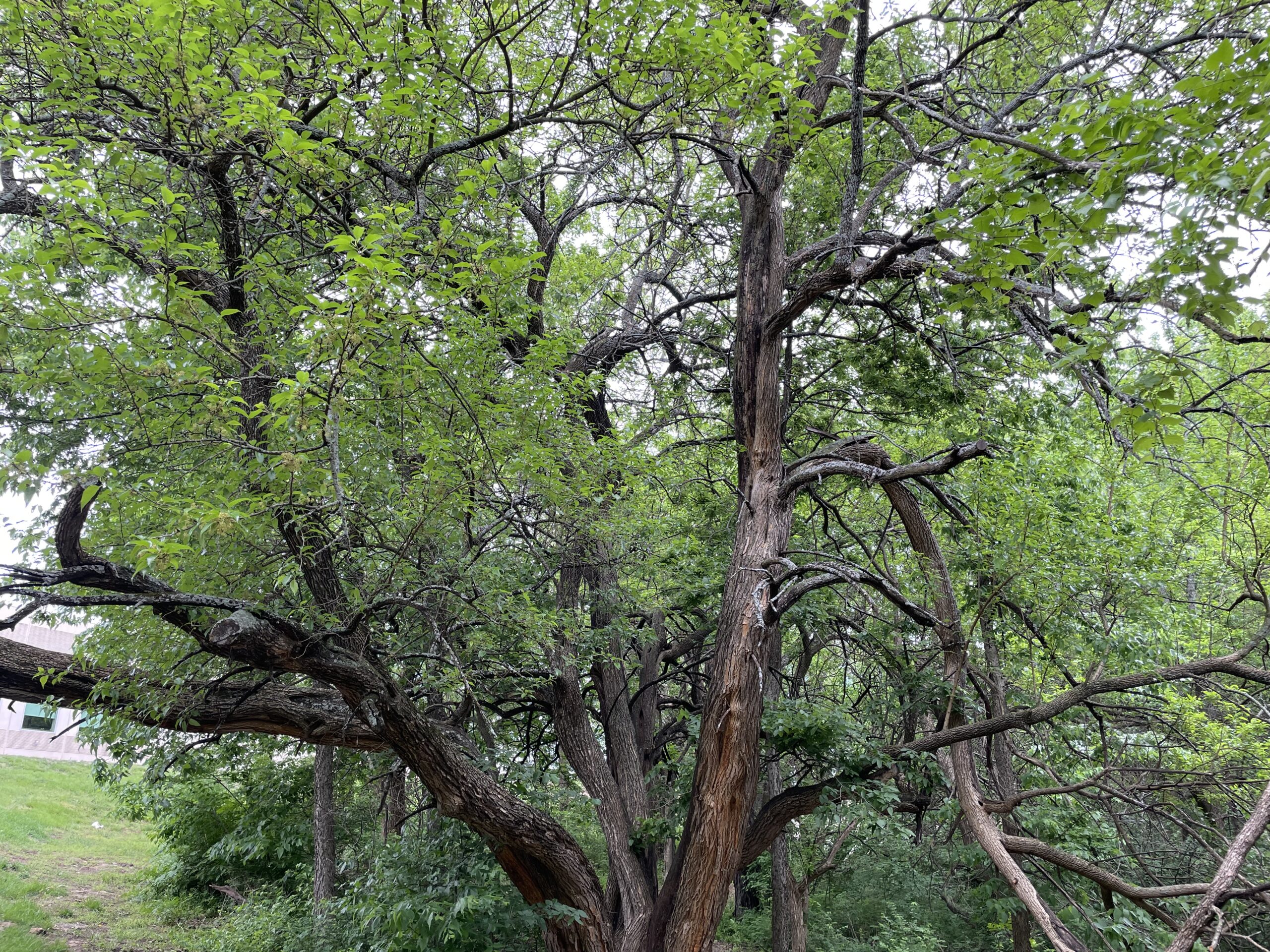Osage Orange
Malclura pomifera

Osage orange in the spring

Osage orange in the woodlands
 The Osage orange tree also known as hedge apple, hedge, horse-apple and yellow wood and other names, has a long and interesting history of use by both Native Americans and pioneers. The French found that the Osage Indians used the wood to make bows and hence called it Bois d’ Arc (meaning wood of the bow).1 The Osage Indians also used the yellow wood for dye making. The Kiowa Tribe used the bark of the roots to make a yellow dye and the Comanche, Omaha, Pawnees and Ponca fashioned bows from the branches. The roots were boiled and the liquid used as a wash for sore eyes.2 Because the wood of Osage orange is decay resistant, it was once in demand for horse drawn wagons, mine support timbers, posts and many other things. It was cultivated in the south in the early 1800’s. It was promoted as a living fence by John Wright. A biolog professor, from Illinois College, Professor Jonathan Turner, was convinced the Osage orange was the best fencing material available. He described the fencing as “horse high, bull strong and pig tight” and was used for that function as a hedge long before the invention of barbed wire. By the 1850’s entire farms were fenced using the Osage orange hedges. More recently the Osage orange has been studied for its chemical properties and its potential as a biodiesel.3
The Osage orange tree also known as hedge apple, hedge, horse-apple and yellow wood and other names, has a long and interesting history of use by both Native Americans and pioneers. The French found that the Osage Indians used the wood to make bows and hence called it Bois d’ Arc (meaning wood of the bow).1 The Osage Indians also used the yellow wood for dye making. The Kiowa Tribe used the bark of the roots to make a yellow dye and the Comanche, Omaha, Pawnees and Ponca fashioned bows from the branches. The roots were boiled and the liquid used as a wash for sore eyes.2 Because the wood of Osage orange is decay resistant, it was once in demand for horse drawn wagons, mine support timbers, posts and many other things. It was cultivated in the south in the early 1800’s. It was promoted as a living fence by John Wright. A biolog professor, from Illinois College, Professor Jonathan Turner, was convinced the Osage orange was the best fencing material available. He described the fencing as “horse high, bull strong and pig tight” and was used for that function as a hedge long before the invention of barbed wire. By the 1850’s entire farms were fenced using the Osage orange hedges. More recently the Osage orange has been studied for its chemical properties and its potential as a biodiesel.3
Osage orange provides shelter and cover for wildlife. Small mammals and birds use the thorny
tree for cover. The fruit of the tree is very distinctive, the surface resembles a brain and is shaped like an orange-like ball, 2-6 inches in diameter, pale green, lumpy, wrinkled, fleshy with milky sticky juice and, oval seeds. The bitter-tasting, fleshy fruit is generally not eaten, but some animals including squirrel, rabbits, white-tail deer, red fox, red crossbill, downy woodpecker and northern bobwhite occasionally eat the seeds. Seedlings and sprouts are also occasionally eaten.4
The tree was often planted in wind breaks. The wood is bright orange, very hard, strong,
heavy coarse-grained and is highly durable. However, Osage orange tends to have an
invasive nature when exposed to poorly managed and over grazed pasture and range land. If not controlled, this plant may become weedy and displace desirable vegetation.
The scientific name Maclura honors William McClure, an early geologist, pomifera means “fruit-bearing.”5 Biologists believe that the large fruits evolved to be eaten and dispersed by
the large herbivores, such as mastodons, which lived on our continent only 20,000-30,000
years ago.6
- USDA Plant Fact Sheet – Osage Orange ↩︎
- Kansas Wildflowers and Grasses – Osage Orange ↩︎
- USDA Plant Fact Sheet – Osage Orange ↩︎
- Air Pollution Effects on Forests: A Guide to
Species Ecology, Ecosystem Services, and
Responses to Nitrogen and Sulfur Deposition
Trees (Volume 1), pg. 80 ↩︎ - Missouri Botanical Garden Link – Osage Orange ↩︎
- Missouri Department of Transportation – Osage Orange Field Guide ↩︎
